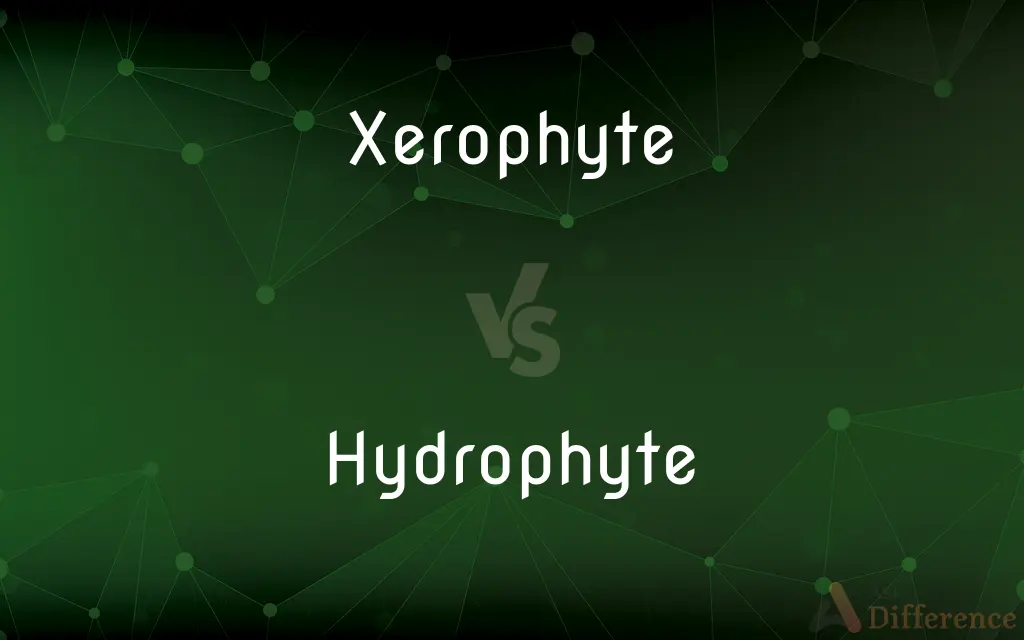Xerophyte vs. Hydrophyte — What's the Difference?
By Maham Liaqat & Fiza Rafique — Updated on May 6, 2024
A xerophyte is a plant adapted to dry, arid environments, while a hydrophyte thrives in water-rich habitats, often submerged or partially submerged.

Difference Between Xerophyte and Hydrophyte
Table of Contents
ADVERTISEMENT
Key Differences
Xerophytes are plants specially adapted to survive in environments with limited water, such as deserts. Hydrophytes, on the other hand, are plants that live in aquatic environments and are adapted to constant moisture.
Xerophytes often feature thick, waxy leaves and deep root systems to maximize water storage and minimize loss. Hydrophytes possess specialized structures like air-filled tissues and flexible stems to adapt to their waterlogged environments.
Xerophytes are adapted to drought conditions, whereas hydrophytes handle being fully submerged by having leaves with thin cuticles or stomata to absorb nutrients directly from water.
Xerophytes often display modified leaves like spines to reduce water loss, while hydrophytes might have floating leaves or stems for optimal light absorption.
Xerophytes are found in deserts or other arid regions, while hydrophytes inhabit wetlands, ponds, lakes, and other water bodies.
ADVERTISEMENT
Comparison Chart
Habitat
Arid regions, deserts
Water-rich environments, wetlands
Leaf Structure
Thick, waxy, sometimes spines
Thin cuticle, floating, submerged
Root System
Deep or extensive to reach water
Shallow or specialized for anchoring
Water Adaptation
Water storage, reduced loss
Tissues adapted for floating or submersion
Photosynthesis
Minimized leaf surface, stomata on undersides
Thin leaves with ample stomata
Compare with Definitions
Xerophyte
A plant adapted to arid conditions.
The cactus is a classic xerophyte found in desert environments.
Hydrophyte
A plant adapted to grow in water-rich environments.
Water lilies are classic hydrophytes, floating on ponds and lakes.
Xerophyte
Vegetation with reduced transpiration.
Aloe vera has a thick cuticle that minimizes water loss, a xerophyte trait.
Hydrophyte
Vegetation that thrives in saturated soil or submerged conditions.
Cattails grow in wetlands and are considered hydrophytes.
Xerophyte
Plants that develop specialized root systems.
Sagebrush is a xerophyte with deep roots for extracting groundwater.
Hydrophyte
A plant requiring abundant moisture for growth.
Hydrophytes like lotuses are dependent on consistent water.
Xerophyte
A plant that conserves water through special adaptations.
Succulents store water in their thick leaves, making them xerophytes.
Hydrophyte
Species with specialized leaf structures to absorb nutrients.
Elodea's leaves extract nutrients directly from the water, typical of hydrophytes.
Xerophyte
A species capable of enduring extreme drought.
The Joshua tree is a resilient xerophyte in the Mojave Desert.
Hydrophyte
Plants that develop air-filled tissues for buoyancy.
Duckweed has air sacs that keep it afloat as a hydrophyte.
Xerophyte
A plant adapted to surviving with little water.
Hydrophyte
A plant adapted to grow in water.
Xerophyte
(botany) Any plant suited for life in a habitat where water is scarce, such as in a desert or chaparral. Such plants may be succulent, have small or reduced leaves, or spines.
Hydrophyte
(botany) A plant that lives in or requires an abundance of water, usually excluding seaweed.
Xerophyte
A xerophyte (from Greek ξηρός xeros 'dry' + φυτόν phuton 'plant') is a species of plant that has adaptations to survive in an environment with little liquid water, such as a desert or an ice- or snow-covered region in the Alps or the Arctic. Popular examples of xerophytes are cacti, pineapple and some Gymnosperm plants.
Hydrophyte
An aquatic plant; an alga.
Xerophyte
A desert plant
Hydrophyte
A plant that grows partly or wholly in water whether rooted in the mud, as a lotus, or floating without anchorage, as the water hyacinth
Xerophyte
Plant adapted for life with a limited supply of water; compare hydrophyte and mesophyte
Common Curiosities
Do hydrophytes thrive in terrestrial environments?
No, hydrophytes require constant water saturation and cannot handle prolonged dryness.
Do xerophytes produce flowers like other plants?
Yes, many xerophytes bloom seasonally, despite challenging conditions.
How do hydrophytes absorb nutrients?
They often absorb nutrients directly from the water through specialized leaves or stems.
Do xerophytes have deep roots?
Many do, as deep roots help them reach water sources, but others rely on surface roots to capture brief rain.
Can hydrophytes photosynthesize underwater?
Yes, many hydrophytes can perform photosynthesis while submerged.
Can xerophytes survive without water for extended periods?
Yes, they are adapted to arid conditions and can store water efficiently.
Are all succulents xerophytes?
Most succulents are xerophytes due to their water-storing adaptations.
Do xerophytes close their stomata during the day?
Some do to minimize water loss, especially in extreme heat.
Are hydrophytes exclusively aquatic?
Not all are fully aquatic; some are partially submerged or grow in very wet soil.
Do hydrophytes grow in saltwater environments?
Some can, especially those with salt-tolerance adaptations like mangroves.
Share Your Discovery

Previous Comparison
Flavour vs. Favor
Next Comparison
Lysine vs. LeucineAuthor Spotlight
Written by
Maham LiaqatCo-written by
Fiza RafiqueFiza Rafique is a skilled content writer at AskDifference.com, where she meticulously refines and enhances written pieces. Drawing from her vast editorial expertise, Fiza ensures clarity, accuracy, and precision in every article. Passionate about language, she continually seeks to elevate the quality of content for readers worldwide.












































